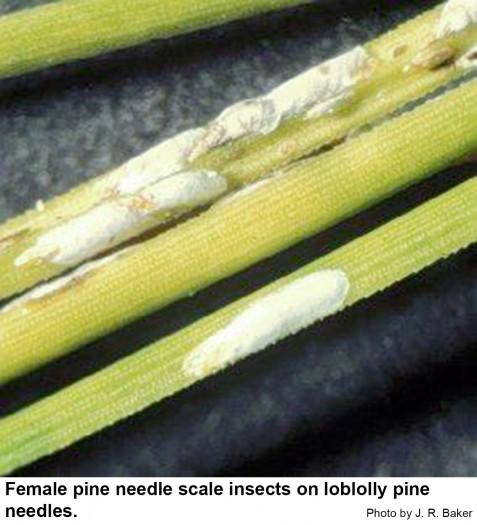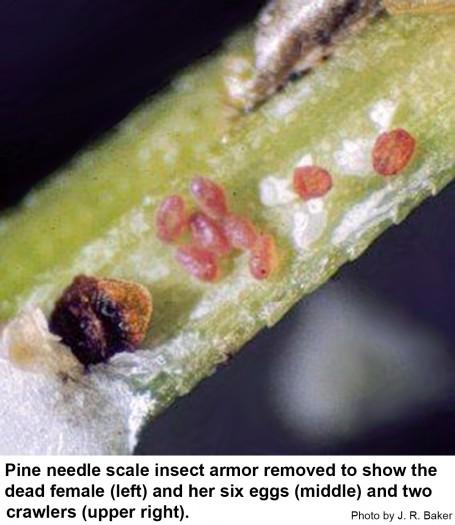Description and Biology
Pine needle scale insects, Chionaspis pinifoliae, overwinter on the needles in the egg stage under the armor of the dead mother scale insect. These reddish brown eggs hatch in the spring. Tiny reddish-purple crawlers emerge from under the old armor and crawl around for a while before settling down on the needles to feed, secrete the characteristic white armor, and grow. When mature, tiny males emerge and crawl or fly to find females with which they mate. The females eventually lay up to 40 eggs that hatch into a second generation. The second generation matures later in the summer and will ultimately produce the overwintering eggs.
Host Plants
The most frequently damaged host plants are the mugo pine and Scots pine. Other pines are infested to a lesser extent. Pine needle scale has also been found on spruce, firs, Douglas-fir, and cedars. Pine needle scales are most damaging to ornamental pine plantings. Heavily infested pines become sickly yellow and suffer premature needle drop and twig dieback.
Residential Recommendation
Pine needle scale is not worth treating if the population is low. However, if there are lots of scales on each needle, it may wise to treat as the scales are certainly not helping the plant. Heavily infested pines become unthrifty and may die back from the tips. If control measures are warranted, work done by Dr. Warren Johnson at Cornell University some years ago showed that pine needle scale insects are susceptible to oil sprays. Use a 4% oil spray during the winter and a 2% oil spray later on in the summer.
References
- Armored Scale Identification and Management on Ornamental Plants. Frank, S. 2010. Entomology Insect Notes, NC State Extension Publications.
- First Generation Pine Needle Scale Crawlers are Afoot. Boggs, J. 2017. Bug Bytes. Buckeye Yard & Garden onLine. Ohio State University.
- Pine Needle Scale, Chionaspis pinifoliae (Fitch). Hoover, G. A. 2002. Insect Advice from Extension. PennState Colleg of Agr. Sci. Dept. Entomology.
- The scale insect; a paragon of confusion. Johnson, W. T. 1982. J. Arboriculture. 8 (5): 113-123.
- NC State Extension Plant Pathology Publications and Factsheets
- NC State Horticultural Science Publications
- North Carolina Agricultural Chemicals Manual
For assistance with a specific problem, contact your local N.C. Cooperative Extension center.
This Factsheet has not been peer reviewed.
Publication date: Feb. 25, 2013
Reviewed/Revised: Oct. 10, 2019
Recommendations for the use of agricultural chemicals are included in this publication as a convenience to the reader. The use of brand names and any mention or listing of commercial products or services in this publication does not imply endorsement by NC State University or N.C. A&T State University nor discrimination against similar products or services not mentioned. Individuals who use agricultural chemicals are responsible for ensuring that the intended use complies with current regulations and conforms to the product label. Be sure to obtain current information about usage regulations and examine a current product label before applying any chemical. For assistance, contact your local N.C. Cooperative Extension county center.
N.C. Cooperative Extension prohibits discrimination and harassment regardless of age, color, disability, family and marital status, gender identity, national origin, political beliefs, race, religion, sex (including pregnancy), sexual orientation and veteran status.



